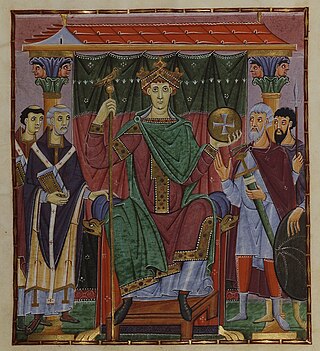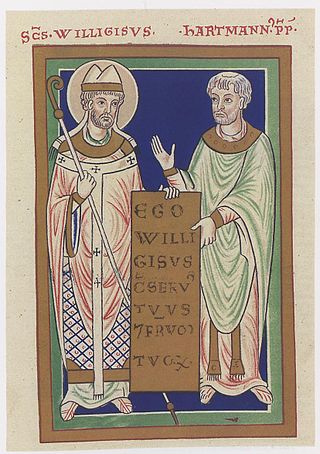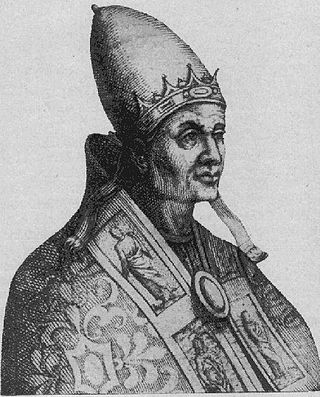Pope Benedict VI was the bishop of Rome and ruler of the Papal States from 19 January 973 to his death in 974. His brief pontificate occurred in the political context of the establishment of the Holy Roman Empire, during the transition between the reigns of Otto I and Otto II, incorporating the struggle for power of Roman aristocratic families such as the Crescentii.

Antipope Boniface VII, otherwise known as Franco Ferrucci, was a Catholic prelate who claimed the Holy See in 974 and from 984 until 985. A popular tumult compelled him to flee to Constantinople in 974; he carried off a vast treasure, and returned in 984 and removed Pope John XIV (983–984) from office. He is supposed to have put Pope Benedict VI to death. After a brief second rule, he died under suspicious circumstances. He is today considered an antipope.
Pope Gregory V, born Bruno of Carinthia, was the bishop of Rome and ruler of the Papal States from 3 May 996 to his death. A member of the Salian dynasty, he was made pope by his cousin, Emperor Otto III.
The 990s decade ran from January 1, 990, to December 31, 999.

Year 984 (CMLXXXIV) was a leap year starting on Tuesday of the Julian calendar.

Otto III was the Holy Roman emperor and King of Italy from 996 until his death in 1002. A member of the Ottonian dynasty, Otto III was the only son of Emperor Otto II and his wife Theophanu.

Year 996 (CMXCVI) was a leap year starting on Wednesday of the Julian calendar.

Year 998 (CMXCVIII) was a common year starting on Saturday of the Julian calendar.

Otto II, called the Red, was Holy Roman Emperor from 973 until his death in 983. A member of the Ottonian dynasty, Otto II was the youngest and sole surviving son of Otto the Great and Adelaide of Italy.
Pope John XIII was the bishop of Rome and ruler of the Papal States from 1 October 965 to his death. His pontificate was caught up in the continuing conflict between the Holy Roman emperor, Otto I, and the Roman nobility. After long and arduous negotiations, he succeeded in arranging a Byzantine marriage for Otto II, in an effort to legitimize the Ottonian claim to imperial dignity. He also established church hierarchy in Poland and Bohemia.
Pope John XIV, born Peter Canepanova, was the bishop of Rome and ruler of the Papal States from December 983 until his death. Upon the death of Pope Benedict VII in July 983, Emperor Otto II nominated Canepanova to the papal throne after the abbot Maiolus of Cluny refused the office. The decision to install the then bishop of Pavia was made without consultation with the clergy and the Roman people, nor was it confirmed by formal election.
Pope John XV was the bishop of Rome and ruler of the Papal States from August 985 until his death. A Roman by birth, he was the first pope who canonized a saint. The origins of the investiture controversy stem from John XV's pontificate, when the dispute about the deposition of Archbishop Arnulf of Reims soured the relationship between the Capetian kings of France and the Holy See.
John XVI was an antipope from 997 to 998.

The Crescentii were a baronial family, attested in Rome from the beginning of the 10th century and which in fact ruled the city and the election of the popes until the beginning of the 11th century.

Willigis was Archbishop of Mainz from 975 until his death as well as archchancellor of the Holy Roman Empire.

Crescentius the Elder, also known as Crescenzio de Theodora, was a politician and aristocrat in Rome who played a part in the papal appointment.

John Crescentius also John II Crescentius or Crescentius III was the son of Crescentius the Younger. He succeeded to his father's title of consul and patrician of Rome in 1002 and held it to his death.

Eckard I was Margrave of Meissen from 985 until his death. He was the first margrave of the Ekkehardinger family that ruled over Meissen until the extinction of the line in 1046.

Papal appointment was a medieval method of selecting the Pope. Popes have always been selected by a council of Church fathers; however, Papal selection before 1059 was often characterized by confirmation or nomination by secular European rulers or by the preceding pope. The later procedures of the Papal conclave are in large part designed to prohibit interference of secular rulers, which to some extent characterized the first millennium of the Roman Catholic Church, e. g. in practices such as the creation of crown-cardinals and the claimed but invalid jus exclusivae. Appointment may have taken several forms, with a variety of roles for the laity and civic leaders, Byzantine and Germanic emperors, and noble Roman families. The role of the election vis-a-vis the general population and the clergy was prone to vary considerably, with a nomination carrying weight that ranged from nearly determinative to merely suggestive, or as ratification of a concluded election.

The Tusculan Papacy was a period of papal history from 1012 to 1048 where three successive relatives of the counts of Tusculum were installed as pope.











